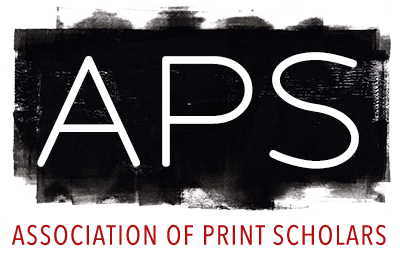Conference or Symposium Announcement
Posted: 05/15/2018
Posted by: Association of Print Scholars
CONF: “Art, Life & Politics: American Printmaking from the 1960s to Today” (4-5 June 2018, Paris)
Fondation Custodia
Paris,
France
06/04/2018-06/05/2018,
10:30am-5pm
The Terra Foundation is honored to collaborate with the Fondation Custodia and the British Museum on the exhibition "The American Dream: Pop to the Present. Prints from the British Museum", a presentation of modern and contemporary American prints fr. . .
om the British Museum collection at the Fondation Custodia in Paris, taking place from June 2–September 2, 2018 .
To mark the opening of The American Dream, join us for "Art, Life & Politics: American Printmaking from the 1960s to Today," a two-day international conference organized in conjunction with the exhibit. Speakers will look at the ways printmaking has engaged with and often challenged American society and politics from the 1960s to today.
The conference is free and will be held in English.
Please RSVP by June 1 to: information@terraamericanart.eu
PROGRAMME
Monday, June 4, 2018
6:00 pm A Conversation: Jim Dine and Ruth Fine
Independent Curator & Curator Emeritus, Prints and Drawings, National Gallery of Art
(By separate invitation only)
Tuesday, June 5, 2018
10:00 am The Making of The American Dream at the British Museum
Stephen Coppel, Curator, Modern Prints and Drawings, British Museum
I. Working Collectively
Moderator: Katherine Bourguignon, Curator, Terra Foundation for American Art
10:30 am Printmaking as a Medium and a Work Procedure in the 1960s and 1970s: Was the Collaborative Nature of Printmaking More Self-Evident to New Art Practices of That Time?
Laurence Schmidlin, Curator of Modern and Contemporary Art, Musée cantonal des Beaux-Arts de Lausanne
11:15 am Coffee break
11:30 am The Bugs in the Chocolate: American Prints and Printing at the 1970 Venice Biennale
Susan Tallman, Adjunct Associate Professor, School of the Art Institute of Chicago & Editor-in-Chief, Art in Print
12:15 am License to Feel: Richard Serra’s Prints
Richard Shiff, Professor, The University of Texas at Austin & Director, Center for the Study of Modernism
1:00 pm Break
II. Getting the Message Across
Moderator: Catherine Daunt, Hamish Parker Curator of Modern and Contemporary Graphic Art, British Museum
2:30 pm ‘A beautiful, incomplete idea’ (Around Jasper Johns’ Flags and Beyond)
Hervé Vanel, Assistant Professor, Art History, The American University of Paris
3:15 pm Printmaking in the Middle of Something: Bob Blackburn and African-American Printmaking during the Graphics Boom
Jacqueline Francis, Associate Professor and Chair, Graduate Program in Visual and Critical Studies, California College of the Arts
4:00 pm Coffee break
4:15 pm Matter(s) of Fact
Elisabeth Lebovici, Independent Art Historian & Critic
5:00 pm Discussion
Exhibition:
The American Dream: Pop to the Present. Prints from the British Museum
June 2–September 2, 2018
Fondation Custodia
121 rue de Lille, 75007 Paris
**For more information, please click on the 'External Link' below.
To mark the opening of The American Dream, join us for "Art, Life & Politics: American Printmaking from the 1960s to Today," a two-day international conference organized in conjunction with the exhibit. Speakers will look at the ways printmaking has engaged with and often challenged American society and politics from the 1960s to today.
The conference is free and will be held in English.
Please RSVP by June 1 to: information@terraamericanart.eu
PROGRAMME
Monday, June 4, 2018
6:00 pm A Conversation: Jim Dine and Ruth Fine
Independent Curator & Curator Emeritus, Prints and Drawings, National Gallery of Art
(By separate invitation only)
Tuesday, June 5, 2018
10:00 am The Making of The American Dream at the British Museum
Stephen Coppel, Curator, Modern Prints and Drawings, British Museum
I. Working Collectively
Moderator: Katherine Bourguignon, Curator, Terra Foundation for American Art
10:30 am Printmaking as a Medium and a Work Procedure in the 1960s and 1970s: Was the Collaborative Nature of Printmaking More Self-Evident to New Art Practices of That Time?
Laurence Schmidlin, Curator of Modern and Contemporary Art, Musée cantonal des Beaux-Arts de Lausanne
11:15 am Coffee break
11:30 am The Bugs in the Chocolate: American Prints and Printing at the 1970 Venice Biennale
Susan Tallman, Adjunct Associate Professor, School of the Art Institute of Chicago & Editor-in-Chief, Art in Print
12:15 am License to Feel: Richard Serra’s Prints
Richard Shiff, Professor, The University of Texas at Austin & Director, Center for the Study of Modernism
1:00 pm Break
II. Getting the Message Across
Moderator: Catherine Daunt, Hamish Parker Curator of Modern and Contemporary Graphic Art, British Museum
2:30 pm ‘A beautiful, incomplete idea’ (Around Jasper Johns’ Flags and Beyond)
Hervé Vanel, Assistant Professor, Art History, The American University of Paris
3:15 pm Printmaking in the Middle of Something: Bob Blackburn and African-American Printmaking during the Graphics Boom
Jacqueline Francis, Associate Professor and Chair, Graduate Program in Visual and Critical Studies, California College of the Arts
4:00 pm Coffee break
4:15 pm Matter(s) of Fact
Elisabeth Lebovici, Independent Art Historian & Critic
5:00 pm Discussion
Exhibition:
The American Dream: Pop to the Present. Prints from the British Museum
June 2–September 2, 2018
Fondation Custodia
121 rue de Lille, 75007 Paris
**For more information, please click on the 'External Link' below.
Relevant research areas: North America, Western Europe, 20th Century, Book arts, Engraving, Etching, Lithography, Monoprinting, Relief printing, Screenprinting
